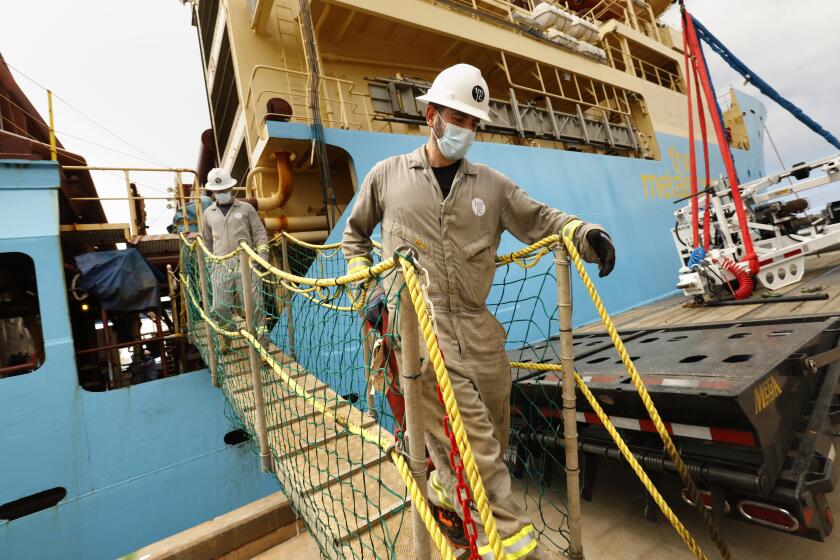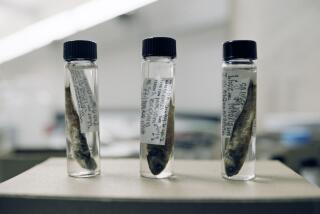Deep-sea metals may be source of oxygen for life on ocean floor

- Share via
Researchers say the polymetallic nodules that mining companies hope to harvest from the deep-ocean seafloor may be a source of oxygen for the animals, plants and bacteria that live there.
This discovery of this “dark oxygen” has the potential to rock negotiations happening this month in Jamaica, where a world rule-making body — the International Seabed Authority — is meeting to decide the future of deep-sea mining.
The work was published recently in the journal Nature Geoscience.
“This study is a really good example of how limited our knowledge of the deep ocean currently is, and how much more we still stand to benefit with further scientific research,” said Diva Amon, a marine biologist from Trinidad and a post-doctoral researcher at UC Santa Barbara’s Benioff Ocean Initiative.
As the International Seabed Authority considers the future of deep-sea mining for battery metals, California and other states are seeking bans against mining.
The excitement is focused on the potato-sized rocks — or polymetallic nodules — found littered across areas of the ocean floor. These nodules contain minerals, such as cobalt and nickel, that green-energy batteries and technologies require.
For years, companies such as Canada’s The Metals Co. have been working to persuade the international governing authority to greenlight their plans to harvest these metallic nodules in the Pacific Ocean’s Clarion Clipper Zone — a stretch of sea that spans 4,500 miles between Hawaii and Mexico.
The company has argued that the metals are essential for building technologies that do not rely on fossil fuels. They say the impact mining will have on the ocean floor is not only minimal, but also doesn’t compare with the destruction of rainforests and human communities that terrestrial mining inflicts.
But environmentalists, oceanographers and others say that driving large harvesting machines across the pristine, little-known ocean floor — atop and along areas of sediment three and four miles below the surface — could have unforeseen and disastrous consequences. They are urging lawmakers to postpone or ban the industry from digging up one of the last “untouched” ecosystems on the planet.
This new research, which was funded by TMC, suggests the toll of mining the area could be greater than anyone had imagined.
That’s because a team of international scientists found that the prized nodules produce oxygen — and may be responsible for enriching this dark, remote ecosystem with one of life’s most important elements.
Unprecedented numbers of gray whales are being spotted in San Francisco Bay, and nobody really knows why. Experts only have educated guesses about the prevalence of porpoises, dolphins and humpback whales too.
Jeffrey Marlow, an assistant professor of biology at Boston University and one of the authors on the paper, said the team leading the research had received funding from TMC to conduct baseline environmental studies, which included sending something to the ocean floor called a benthic chamber.
These structures, which he described as being about 10 feet tall — “think of it as just like an overturned box or something that you jab into the seafloor,” Marlow said — are watertight and gas tight, and contain instruments designed to take measurements of the sediment’s chemistry and composition.
The sampling method is pretty standard, he said. Scientists measure the amount of oxygen that is lost, or declines, during a 48-hour period as the chamber sits in place on the ocean floor. The decline serves as a proxy for the amount of life down there — as animals respirate, they consume oxygen.
But when they sent the chambers down for this analysis, they noticed that oxygen levels went up, not down.
Marlow said they were certain the machinery was faulty. They tried again and noticed the same results.
“These benthic chamber experiments have been done around the world for decades,” he said. “So the technology and everything is pretty well established.”
He said they spent days, then weeks troubleshooting.
“We had a couple of redundant ways of measuring it, so we knew that not one of them was failing. Ultimately, we were forced to conclude” that oxygen was being produced.
What the researchers think is happening is that nodules — and the metals in them — are working like a battery, at a chemical level.
“These rocks are made up of minerals which have metals that are ... distributed throughout the rock in heterogeneous ways,” he said. “Each of these metals and minerals is able to hold on to an electrical charge in a slightly different way. So essentially, just the natural variation means that there is charge separation ... in the same way there is on a battery.”
That means there’s enough voltage to take water and “split it open in hydrogen and oxygen.”
As mining companies look to the seafloor for critical metals, environmentalists say California’s Right to Repair law could help avert ecological harm.
But not everyone is convinced by — or happy with — the study’s conclusion.
TMC, which sponsored the research, sent The Times a critique of the paper, stating the research had been rejected by four scientific publications until finding a home at Nature, which the company described as “a journal that has taken a strong view against deep-sea mineral sourcing.”
A request for comment went unanswered by the journal’s communications team, but the periodical is generally regarded as one of the most prestigious and selective publications among scientists.
TMC also said the methodology was flawed, arguing that the team’s findings contradicted other work that had been conducted in the Clarion Clipper Zone, but which used a different method.
“This inability to reproduce the findings with both methods suggests that elevated oxygen levels are in fact an artefact in the data,” said the company in a statement. The company noted it was “currently preparing a peer-reviewed paper as rebuttal.”
Bo Barker Jørgensen, a microbiologist at Denmark’s Aarhus University — who was not involved with the research or on TMC’s payroll — said the work elicited more questions than it did answers.
He said he did not “think this discovery is important for our understanding of the ocean in general or for deep-sea mining” and described the research as a “novel and very puzzling process for which the mechanism is still not clear.”
The study’s authors pushed back on the critiques, stating they too had been puzzled by their findings — but they’d been rigorous in eliminating every other possible scenario.
“We were the worst critics of this paper for a long time,” said Andrew Sweetman, leader of the Seafloor Ecology and Biogeochemistry research group at the Scottish Assn. for Marine Science, and lead author on the paper. “For eight years I discarded the data showing oxygen production, thinking my sensors were faulty. Once we realised something may be going on, we tried to disprove it, but in the end we simply couldn’t.”
He said he welcomed more research on the topic and urged other scientists to investigate further.
“Following the publication of this paper, I have been approached by other researchers with similar data sets also showing evidence of dark oxygen production that they discarded thinking equipment was faulty,” he said.
Toward a more sustainable California
Get Boiling Point, our newsletter exploring climate change, energy and the environment, and become part of the conversation — and the solution.
You may occasionally receive promotional content from the Los Angeles Times.









